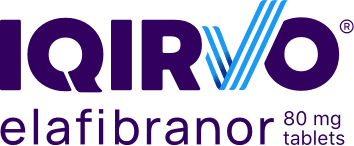PBC management
UDCA is the first-line treatment for PBC, but up to 50% of patients do not adequately respond to UDCA alone, putting them at risk of uncontrolled disease progression1,2
ALP or bilirubin levels may rise over time, even in patients who respond well to first-line treatment3,4
UDCA treatment alone may not achieve biochemical response, ALP normalization, or symptom relief5
Expert recommendations for PBC treatment include4-9:
Monitoring liver lab tests every 3-6 months with evaluation of UDCA response at 6-12 months5,6
Pursuing ALP normalization—which is linked to better long-term outcomes7
Prioritizing quality
of life including symptom management8
Routinely asking your patients about pruritus and fatigue and using available scales to clinically evaluate their impact4,9
Inadequate
12-month response to UDCA can be predicted at 6 months2
According to predictive modeling based on a Global PBC Study Group analysis, an ALP threshold of 1.9 x ULN at 6 months predicts both UDCA treatment response and long-term outcomes2
This threshold is associated with a 90% negative predictive value of UDCA response, or only 10% risk of overtreating2
Transplant-free survival was higher among patients with ALP ≤1.9 x ULN at 6 months compared with ALP >1.9 x ULN at 6 months2
A primary goal of adding a second-line therapy is to achieve the lowest ALP level possible6
ALP=alkaline phosphatase; PBC=primary biliary cholangitis; PPAR=peroxisome proliferator–activated receptor; ULN=upper limit of normal; UDCA=ursodeoxycholic acid.
References: 1. Hirschfield GM, Chazouillères O, Cortez-Pinto H, et al. A consensus integrated care pathway for patients with primary biliary cholangitis: a guideline-based approach to clinical care of patients. Expert Rev Gastroenterol Hepatol. 2021;15(8):929-939. 2. Murillo Perez CF, Ioannou S, Hassanally I, et al; Global PBC Study Group. Optimizing therapy in primary biliary cholangitis: alkaline phosphatase at six months identifies one-year non-responders and predicts survival. Liver Int. 2023;43(7):1497-1506. 3. Gatselis NK, Goet JC, Zachou K, et al; Global Primary Biliary Cholangitis Study Group. Factors associated with progression and outcomes of early stage primary biliary cholangitis. Clin Gastroenterol Hepatol. 2020;18(3):684-692. 4. European Association for the Study of the Liver. EASL Clinical Practice Guidelines: the diagnosis and management of patients with primary biliary cholangitis. J Hepatol. 2017;67(1):145-172. 5. Lindor KD, Bowlus CL, Boyer J, et al. Primary biliary cholangitis: 2018 practice guidance from the American Association for the Study of Liver Diseases. Hepatology. 2019;69(1):394-419. 6. Kowdley KV, Bowlus CL, Levy C, et al. Application of the latest advances in evidence-based medicine in primary biliary cholangitis. Am J Gastroenterol. 2023;118(2):232-242. 7. Murillo Perez CF, Harms MH, Lindor KD, et al; Global PBC Study Group. Goals of treatment for improved survival in primary biliary cholangitis: treatment target should be bilirubin within the normal range and normalization of alkaline phosphatase. Am J Gastroenterol. 2020;115(7):1066-1074. 8. Levy C, Manns M, Hirschfield G. New treatment paradigms in primary biliary cholangitis. Clin Gastroenterol Hepatol. 2023;21(8):2076-2087. 9. Faisal A. Understanding fatigue and pruritus in primary biliary cholangitis. Clin Liver Dis (Hoboken). 2024;23(1):e0216. 10. IQIRVO [package insert]. Ipsen Biopharmaceuticals, Inc. Cambridge, MA.

